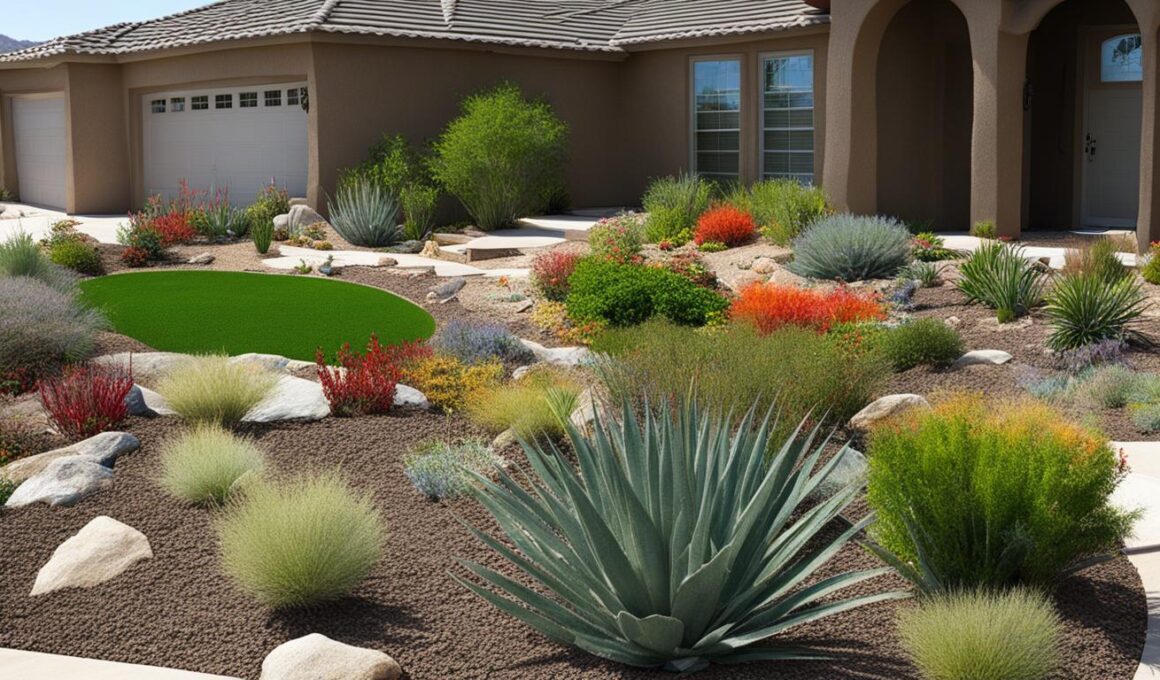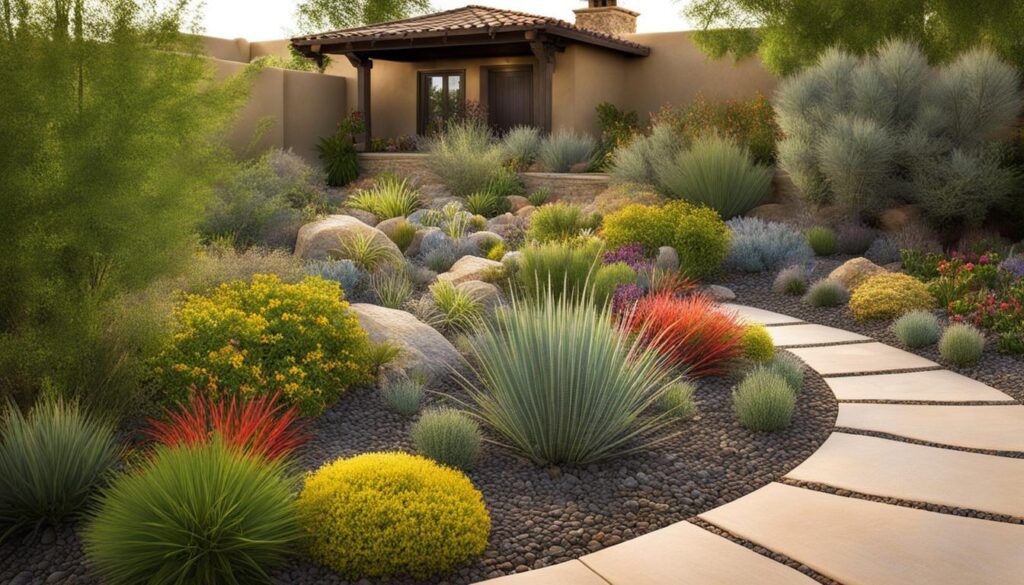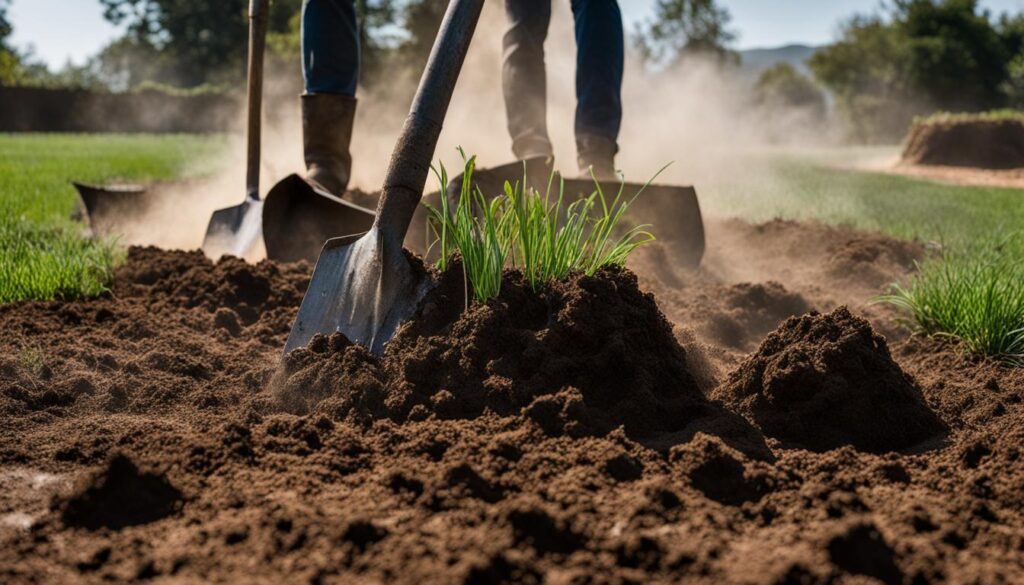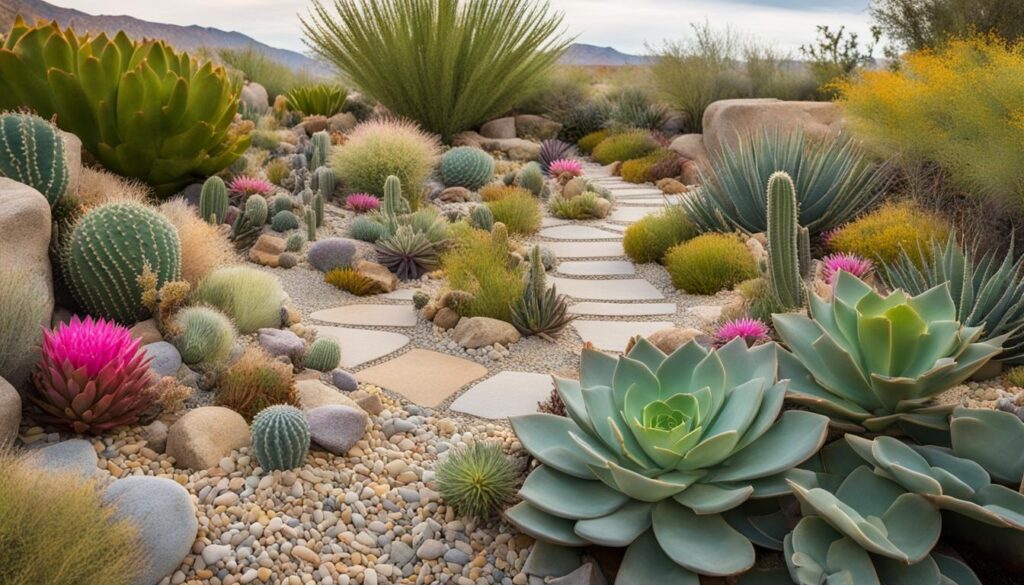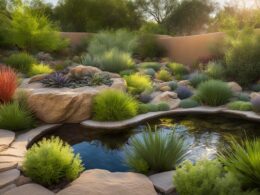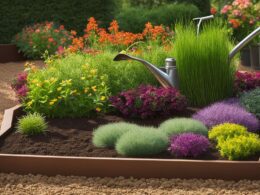Converting a traditional lawn to a xeriscape garden is a great way to save water and create a beautiful and sustainable outdoor space. Xeriscape landscaping uses drought-tolerant plants and efficient irrigation techniques to reduce water usage. In this comprehensive guide, we will provide step-by-step instructions on how to convert your lawn to a xeriscape garden. We will cover important considerations like observing your yard, learning about drought-tolerant plants, removing the grass lawn, and planting xeric plants. By following these steps, you can transform your lawn into a drought-tolerant oasis.
Key Takeaways
- Converting to a xeriscape garden can help save water and create a sustainable outdoor space.
- Xeriscape landscaping uses drought-tolerant plants and efficient irrigation techniques.
- Observing your yard and designating sun and water zones is crucial for planning your xeriscape garden.
- Research and choose drought-tolerant plants that are well-adapted to your specific location.
- Removing the grass lawn can be done through physical removal, solarization, or sheet mulching methods.
Observing Your Yard and Designating Sun and Water Zones
Before embarking on your xeriscape project, take the time to observe your yard and designate the different sun and water zones. This step is crucial in planning and designing your xeric garden according to the specific needs of each area.
Start by noting the areas in your yard that receive full sun, part sun, and full shade during the growing season. This will help you determine which plants will thrive in each zone. Divide your yard into hydrozones, which represent the water use needed for each area. High-water use zones can be designated for herbs and vegetables, while moderate-use zones act as a transition between high and low-use areas. The lowest water use zone is perfect for xeric plants that require minimal watering.
By understanding the sun and water zones in your yard, you can strategically plan the layout of your xeric garden. This will ensure that each plant receives the appropriate amount of sunlight and water, maximizing their growth and water efficiency. It will also help you choose the right plants for each zone, considering their specific requirements.
Observing Your Yard:
- Identify areas of full sun, part sun, and full shade in your yard.
- Note the conditions during the growing season.
Designating Sun and Water Zones:
- Divide your yard into hydrozones based on water usage needs.
- Allocate high-water use zones for herbs and vegetables.
- Create moderate-use zones as a transition between high and low-use areas.
- Dedicate the lowest water use zone to xeric plants.
By carefully observing your yard and designating the sun and water zones, you set the foundation for a successful xeriscape garden. This thoughtful planning will allow you to create a beautiful and water-efficient outdoor space that thrives in harmony with nature.
Learning About Drought-Tolerant Plants in Colorado
When it comes to creating a xeriscape garden in Colorado, selecting the right plants is essential. Drought-tolerant plants, also known as xeric plants, are adapted to thrive in arid climates and require less water compared to traditional garden plants. By choosing xeric plants for your Colorado xeriscape garden, you can have a beautiful and sustainable outdoor space that conserves water.
Researching and learning about drought-tolerant plants that are suitable for Colorado is the first step in creating a successful xeriscape garden. Different regions within the state may have varying soil conditions and climate, so it’s important to choose plants that are well-suited to your specific location. Native plants and those recommended for Colorado, such as those found in the Garden in a Box program, are excellent choices for xeric gardens. These plants have evolved to thrive in the state’s unique climate and often require less water and maintenance.
When selecting xeric plants, consider factors such as their water requirements, growth habits, and aesthetic appeal. Some popular drought-tolerant plants in Colorado include Blue Flax (Linum lewisii), Rocky Mountain Penstemon (Penstemon strictus), and Purple Coneflower (Echinacea purpurea). These plants not only add beauty to your xeriscape garden but also attract pollinators like butterflies and bees. By incorporating a variety of xeric plants in your garden, you can create a diverse and visually appealing landscape while conserving water.
Remember to also consider the specific needs of each plant, such as soil type, sun exposure, and spacing requirements. By providing the optimal growing conditions for your xeric plants, you can ensure their long-term success and minimize maintenance efforts. Whether you’re a seasoned gardener or a beginner, growing drought-tolerant plants in Colorado can be a rewarding and environmentally-friendly way to create a beautiful outdoor space.
Removing the Grass Lawn and Preparing the Soil
Converting your lawn to a xeriscape garden begins with removing the existing grass lawn and preparing the soil for the new plants. There are a few different methods you can choose from to remove the grass effectively. One option is physical removal, which involves using a rototiller or shovel to dig up the grass and its roots. This method requires some manual labor but is an efficient way to clear the space.
If you prefer a more natural approach, solarization can be used to kill the grass. This method involves covering the lawn with clear plastic to trap heat from the sun, which in turn kills the grass and any weed seeds present. Solarization typically takes a few weeks to be effective, so plan accordingly.
Another method is sheet mulching, also known as the lasagna method. This technique requires layering cardboard or newspaper over the grass, followed by a layer of compost and organic mulch. The layers smother the grass and create a nutrient-rich environment for the new plants to thrive. Sheet mulching takes time, but it is a sustainable and effective way to convert your lawn to a xeriscape garden.
Preparing the soil
After removing the grass, it’s important to prepare the soil for the new plants. Start by testing the soil pH and making any necessary adjustments to ensure optimal growing conditions. Adding organic matter, such as compost or well-rotted manure, can improve soil structure and nutrient content.
Incorporating organic matter also helps improve the soil’s water retention capabilities, which is crucial for xeriscape gardens. Mulching the soil surface with a layer of organic mulch, such as wood chips or straw, can further enhance water retention and reduce weed growth. It also helps regulate soil temperature and protects the soil from erosion.
By removing the grass lawn and preparing the soil properly, you are setting the foundation for a successful xeriscape garden. The next step is to select and plant drought-tolerant plants that will thrive in your newly converted space.
Planting Xeric Plants and Designing Your Xeriscape Garden
Now that you have prepared the soil, it’s time to bring your xeriscape garden to life. Planting xeric plants and carefully designing your outdoor space will create a visually stunning and water-efficient landscape.
When selecting the plants for your xeriscape garden, consider their growth habits and recommended planting distances. Be mindful of the mature size of each plant to ensure they have enough space to thrive. Remember, xeric plants are known for their ability to withstand drought conditions, so choose plants that are well-suited for your region.
After planting, it’s essential to provide proper care to establish a healthy and resilient garden. Water deeply and infrequently to encourage deep root growth, allowing the plants to become more drought-resistant. Applying an organic fertilizer and compost can help reduce transplant shock and promote strong root development.
Mulching is an important step in xeric garden design. Mulch helps retain moisture, suppresses weeds, and regulates soil temperature. For truly xeric plants, consider using gravel or rock mulches, which provide excellent drainage. Organic mulches, such as bark chips or straw, are ideal for plants that benefit from additional water retention.
Designing Your Xeriscape Garden
When designing your xeriscape garden, consider incorporating hardscape elements like flagstone patios or pathways. These features not only add visual interest but also reduce the amount of water-intensive plantings required. Hardscapes can create focal points and define different areas within your garden.
Remember, a well-designed xeriscape garden can be a beautiful and sustainable addition to your outdoor space. By carefully selecting drought-tolerant plants, providing proper care, and incorporating hardscape elements, you can create a xeric garden that is both environmentally friendly and visually appealing.
With these steps in mind, you are well on your way to creating a stunning xeriscape garden that will thrive even in dry conditions. Enjoy the beauty and water-saving benefits of a xeric landscape.
Can I Use Your Converting Lawn to Xeriscape Guide to Plan My Xeriscape Yard?
Yes, you can use our Converting Lawn to Xeriscape Guide for planning a waterwise yard. It provides valuable information on how to transition from a traditional lawn to a xeriscape yard, including tips on selecting drought-tolerant plants and optimizing water usage.
Conclusion
Converting your lawn to a xeriscape garden offers a multitude of benefits for both you and the environment. By embracing xeriscape landscaping, you can contribute to water conservation efforts while creating a sustainable and visually appealing outdoor space.
Xeriscape Landscaping Benefits
One of the primary advantages of xeriscape landscaping is water conservation. By using drought-tolerant plants and implementing efficient irrigation techniques, you can significantly reduce your water usage. This not only helps preserve water resources but also lowers your water bills.
In addition to water conservation, xeriscape gardening promotes sustainable practices. By choosing native or recommended plants for your xeric garden, you are supporting the local ecosystem and reducing the need for synthetic fertilizers and pesticides. Xeriscape gardens also require less maintenance, minimizing the use of machinery and reducing greenhouse gas emissions.
Create a Beautiful and Sustainable Outdoor Space
Transforming your lawn into a xeriscape garden allows you to create a beautiful and sustainable outdoor space. With the right selection of drought-tolerant plants, you can achieve a vibrant and diverse landscape that thrives in Colorado’s climate. By incorporating hardscape elements such as flagstone patios or pathways, you can enhance the visual appeal and functionality of your xeriscape garden.
Embrace the beauty and sustainability of xeriscape landscaping in your backyard today. By following the step-by-step instructions provided in this guide, you can create a water-saving oasis that requires less maintenance and contributes to the conservation of precious water resources. Start your xeriscape journey and enjoy the benefits of a sustainable and visually stunning outdoor space!





